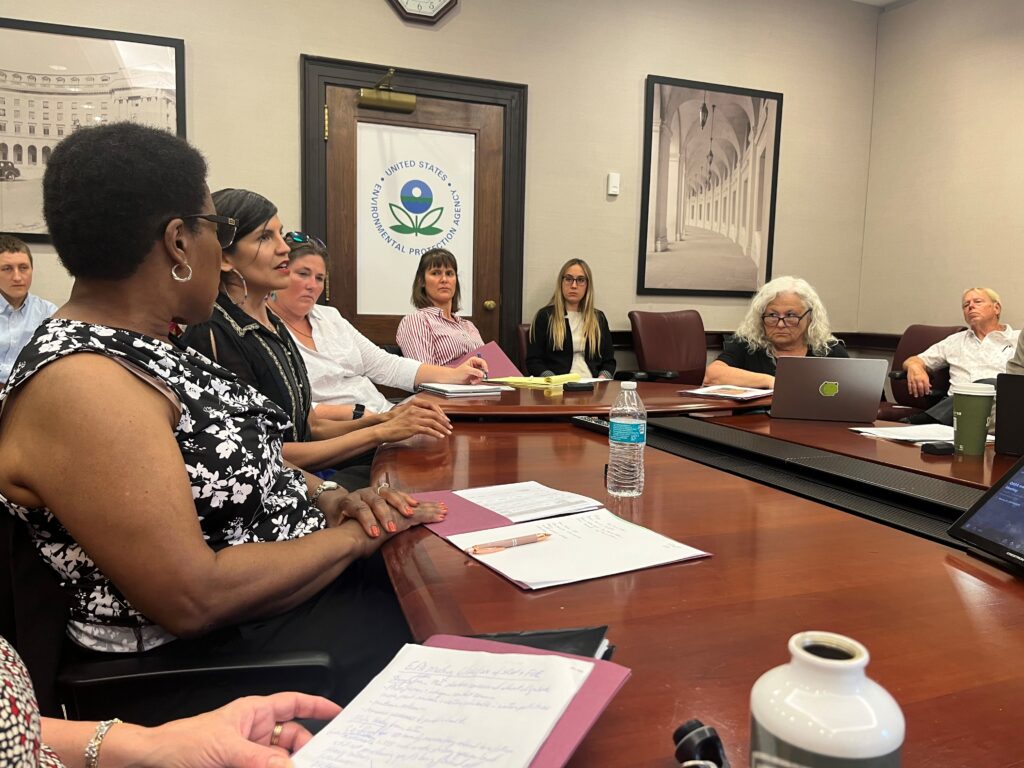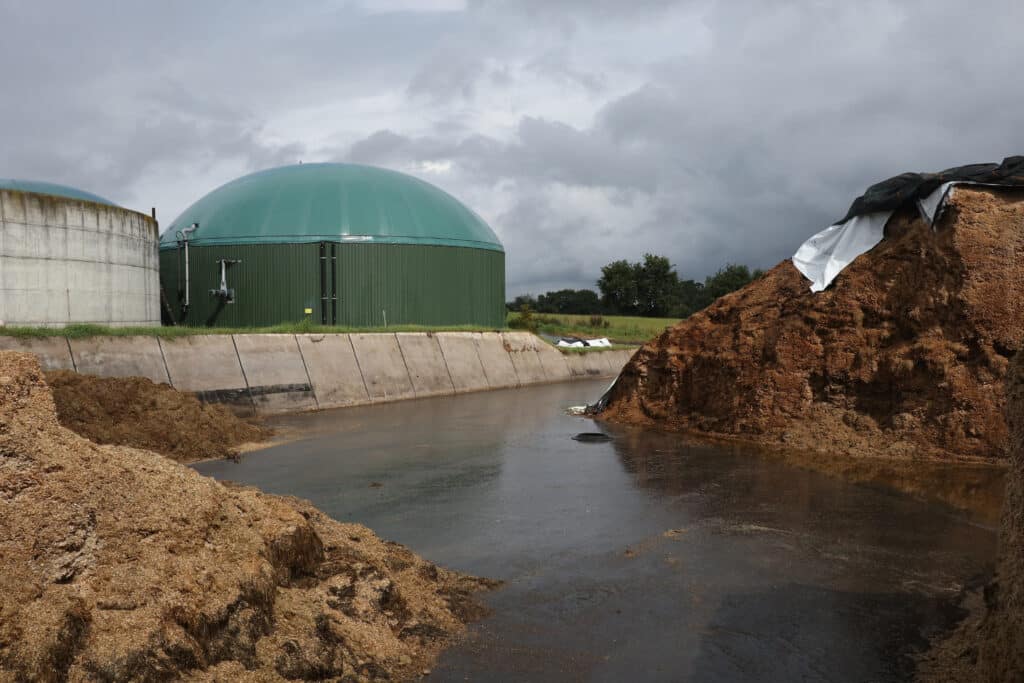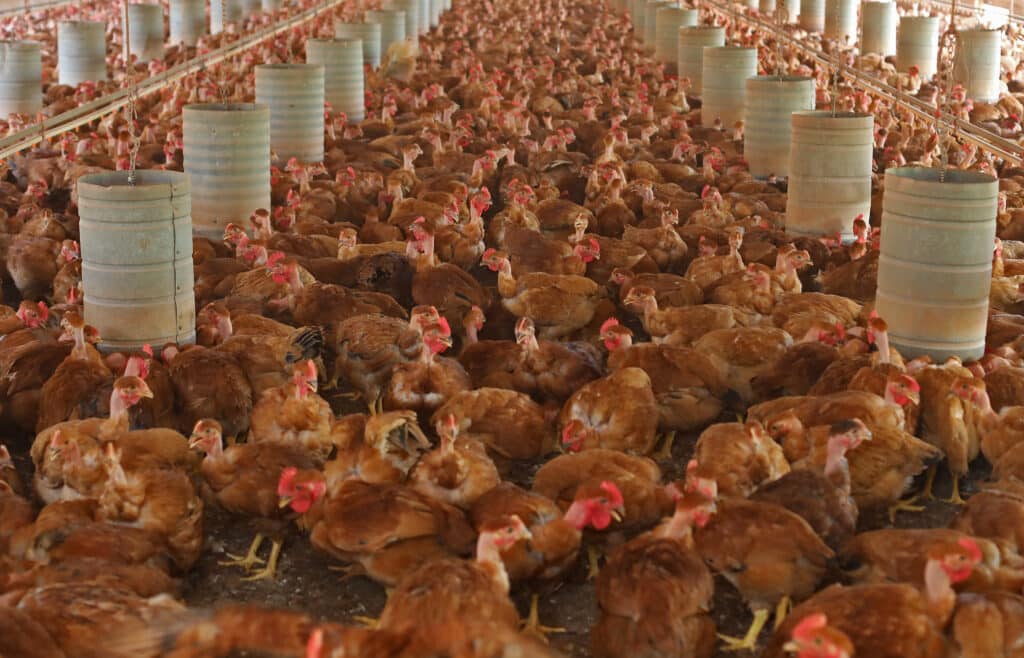- Blog
- Food & Agriculture
- Animal Agriculture
- Manure biogas is a climate smokescreen for big agriculture
Manure biogas is a climate smokescreen for big agriculture

Donate Now!
Your contribution will benefit Friends of the Earth.
Stay Informed
Thanks for your interest in Friends of the Earth. You can find information about us and get in touch the following ways:
by Molly Armus, animal agriculture policy program manager
Now that more and more people are recognizing factory farms’ dangerous impact on public health and the planet, Big Ag and the fossil fuel industry have a new tactic to greenwash this dirty business. Factory farm gas (also known as biogas) is produced from the methane emissions of animal waste on these massive farms, and is now being marketed as “renewable energy.” In fact, it does little to contain the emissions fueling climate change and enables industrial livestock operations to continue abusing animals, threatening public health, and polluting the environment.
This climate and health boondoggle is unfortunately gaining traction, as the 2022 Inflation Reduction Act, long existing conservation rural energy programs and state-level programs have provided millions to support it. Friends of the Earth is working with advocates and rural communities around the country to end these wasteful government subsidies and show policymakers how harmful these programs are. Here we share some stories from frontline rural community members who came to Washington in the summer of 2024 to ask policymakers to stop subsidizing greenwashing.

What is manure biogas and why is it a problem?
The majority of the animals used for food in the U.S. are raised on factory farms, also known as concentrated animal feeding operations (CAFOs). These industrial facilities confine hundreds and sometimes even thousands of animals on one farm, and generate massive amounts of toxic manure that pollute nearby communities’ air and water. They are also a colossal contributor to climate change: The EPA’s latest greenhouse gas inventory shows that animal agriculture is the largest source of methane emissions and a major contributor to nitrous oxide emissions, two highly potent climate pollutants.
However, rather than transforming this harmful, toxic industry into one that prioritizes the health of humans, animals and the planet, industrial animal agriculture is unsurprisingly pushing manure biogas as a quick fix to its climate-warming emissions. Anaerobic digesters are employed to capture methane emissions from manure and produce manure biogas. During anaerobic digestion, bacteria break down the animal waste in the digester – a closed, oxygen-free environment. What is left behind from bacteria “eating” the waste is a combination of gases, primarily methane and carbon dioxide (the factory farm gas), as well as solid and liquid material (also called “digestate” and “effluent”). The captured gas can be used to generate heat or electricity on-site or electricity sold onto the electric grid, processed into so-called “Renewable Natural Gas,” or converted to Compressed Natural Gas (CNG) or Liquefied Natural Gas (LNG) and used as vehicle fuel.
But it’s not really a fix at all: Research indicates that digesters are an insufficient approach to reducing the livestock industry’s climate emissions. Meanwhile, manure biogas fails to address the myriad problems stemming from industrial livestock production, hurts smaller-scale sustainable farms and generates new problems for already overburdened communities, as Friends of the Earth and partners found in Tulare County, California.
Unfortunately, government programs have bought into the ruse. Through programs like the federal Renewable Fuel Standard and California’s Low Carbon Fuel Standard, CAFOs receive lucrative credits for capturing methane emissions. This allows them to sell the factory farm gas as greenwashed “renewable” natural gas, despite the fact that burning biogas produces the same climate emissions as fossil gas. Even worse, research shows that burning factory farm gas creates more toxic air pollution than burning fossil gas.
The production and use of biogas hurts communities in numerous ways. Hear from community members about how it’s affecting them:
Polluting the air and water
The massive amounts of manure industrial-scale farms generate each year—more than one billion tons—pollutes nearby communities’ air and water. The manure is typically stored in giant lagoons and the liquid waste is periodically applied to spray fields. This toxic waste can carry pathogens such as bacteria and viruses, excessive nutrients, and oxygen-demanding organics and solids that contaminate and kill local marine life and severely impact water quality in rivers, streams, and groundwater. The odor plumes, which pervade nearby communities, contain respiratory and eye irritants including hydrogen sulfide and ammonia that cause serious health issues, including asthma and chronic obstructive pulmonary disease.
Manure biogas production worsens these already toxic conditions. It generates additional environmental and public health concerns for communities living near CAFOs, including increased ammonia emissions during anaerobic digestion, higher concentrations of nutrients in digestate that contribute to water pollution, and new pipelines and trucks to transport manure or biogas.
The Buffalo National River watershed is a vital water source for communities across Arkansas. It is home to 135 miles of free-flowing river water that people can enjoy by paddling, hiking, or camping. Now, a number of local poultry operations are beginning to develop biogas. This could mean the factory farms continue to grow and may begin to dump digestate into the watershed, which could seriously damage the watershed through nutrient overloading, contaminating the groundwater and algae blooms that make the water unusable. What’s more, the damage to the watershed could hurt the local economy as tourists lose interest in visiting and property values decrease.
Dane Schumacher with the Buffalo River Watershed Alliance in Arkansas is seeing the impact of such farms on the local watershed
The production and use of manure biogas hurts communities in numerous ways. Hear from community members about how it’s affecting them.

Harm to rural communities
As so often happens with environmental pollution, the destructive impacts of nearby factory farms and biogas production land most heavily on disadvantaged rural communities. Numerous studies show that communities closest to CAFOs that will bear the brunt have disproportionately higher Black, Latinx, and low-wealth populations.
I come from Sampson County, North Carolina, which is the second-largest hog producing county in the United States. We are also number one in turkey production in the state. Around 40% of our residents are on residential well-water. Private wells are seeing increases in contaminants…nitrates, hydrogen sulfide, ammonia…all the things that we know are directly associated with CAFOs. The CAFOs are a huge issue, but we’re also concerned about the other sources of environmental pollution. The EPA needs to do something about cumulative impacts for states to follow when making permitting decisions in order to protect communities like the one that I come from.
Sherri White-Williamson with Environmental Justice Community Action Network speaks to what such communities are experiencing in North Carolina
The greenwashing monetization of these harmful [biogas] build-outs doubles down on the sacrifice of water, land, people, and wildlife for the sake of profit, and the result will be more sickness and degradation at the very time our living ecosystem simply cannot take any more abuse.
Nichole Keway Biber with Clean Water Action speaking to her experience in Michigan

Climate change
Animal agriculture is already a major driver of climate change – and it continues to get worse: While overall U.S. methane emissions have decreased by 19% between 1990 and 2022, methane emissions from the agriculture sector have increased by 14.5%.
There is ample evidence that anaerobic digesters yield a much lower reduction in methane emissions in practice than estimated by the federal government, and that these reductions are highly variable and uncertain due to a lack of monitoring. For instance, anaerobic digestion and storage of digestate releases additional greenhouse gases (GHGs), such as nitrous oxide, undercutting methane emission reductions. Research has also shown that biogas supply chains leak more than EPA estimates, releasing additional methane into the atmosphere.
New research from Friends of the Earth and the Socially Responsible Agriculture Project provides evidence that the staggering amount of state and federal government incentives and subsidies supporting the production of manure biogas, perversely, may be encouraging herd sizes to grow and livestock operations to consolidate to produce more methane (manure). Moreover, despite extensive public investments in digesters, the federal government is not monitoring or reporting on methane emissions from CAFOs with digesters to truly understand the impact they have on climate emissions.
CAFOs and the biodigesters that encourage them to increase in size are an industrial blight in rural America. Biodigesters in my area and across the nation do not produce the energy expected. They are not an answer to climate change as intended. Instead, they are greenwashing, a waste of tax dollars, insufficiently regulated and unpoliced pollution hazards. They are more a part of the climate change problem than any solution to it.
Nancy Meyer, Nebraska
Consolidating the industry
Virtually every sector of the U.S. farm economy has experienced consolidation in the last several decades. Incentives for manure biogas can exacerbate consolidation and create an even more unfair playing field for producers, especially smaller scale regenerative farmers that are managing waste in a more sustainable manner. Anaerobic digesters are expensive to construct and operate, making them economically feasible only for the largest industrial operations and only with considerable public subsidies in most cases. Digesters also rely on wet, methane-generating systems of manure management (i.e., lagoons or deep pits). Thus, dairy and hog producers that do not collect manure in lagoons (namely, small-scale, pasture-based livestock producers) are fundamentally excluded from market opportunities to produce manure biogas, giving the CAFOs that they compete with a further competitive advantage.
In August 2019 my husband and I learned that a neighbor had received a postcard about a hearing to approve a permit to build a 12-barn chicken CAFO on the slope behind his home. We were horrified to find there would be ½ million chickens cycled in and out of those barns on an eight-week cycle, with all the accompanying heavy truck traffic and noise. Despite hiring an attorney and trying our best to influence the local zoning board that this facility was too big and too close to too many people, there were no regulations prohibiting or even restricting it, so it was ultimately approved with some minor conditions. The CAFO went in, and most conditions have never been met. Other than merely recording complaints, there is no framework for enforcement.
Nancy Meyer, Nebraska
When we moved to rural eastern Nebraska in 2000, we could drink our well water unfiltered and eat fish from local waterways. That is no longer the case. When the CAFO manure is spread on the ground opposite our home, we are subjected to an eye-stinging stench lasting for several days. The existence of the CAFO has reduced our home’s value and our quality of life.

What should policymakers do?
Despite the clear evidence that manure biogas contributes to the problem rather than solution, too many policymakers on both sides of the aisle have been blinded by the industry’s assurances of its effectiveness. The hundreds of millions of dollars in programs and tax incentives from the Inflation Reduction Act that support manure biogas is leading to the proliferation of digesters and factory farm gas production around the country. At the end of July 2024, the Environmental Protection Agency (EPA) announced $4.3 billion in IRA-authorized grant funding, most of which is supporting important community-driven climate projects, but it also includes factory farm gas-related projects in Illinois, Minnesota and Nebraska.
Yet hope remains: It’s not too late to curb further investment into manure biogas when we educate policymakers about the real threats.
The civil servants we spoke with [during the fly-in] let it be known that the industry representatives in favor of digesters had presented everything as a “win-win.” They conveyed their appreciation for the frontline communities and environmental advocates who communicated the numerous negatives, as the information and testimony we offered was sometimes completely new, definitely eye-opening and necessary to the conversation.
Nicole from Michigan
The way forward
To prevent even more tax dollars from further entrenching the factory farming system under the false banner of climate mitigation, policymakers must end subsidies and support for this corporate welfare and instead prioritize solutions that support a just transition away from factory farming to regenerative agriculture. Government resources at both the state and federal level that are currently supporting manure biogas should be redirected to more cost-effective methane reduction solutions that do not exacerbate harm to rural communities and industry consolidation.
